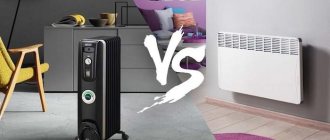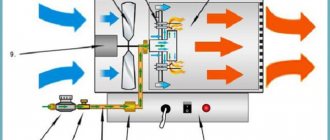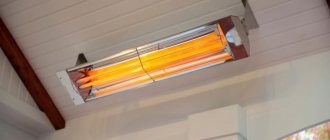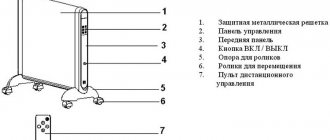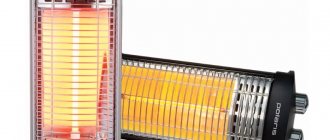The question on the agenda is: a heat gun or an infrared heater - this is the choice faced by people who need, so to speak, a household heater. Let us assume that you are one of them. Or? If not, please write in the comments why you are choosing between these two types of heating systems. But let's return to our guns.
A heat gun is a high-power portable heater, usually used to quickly heat large rooms.
Heat guns use:
- Liquid fuel - diesel fuel or kerosene;
- Gas;
- Electricity.
In the body of any heat gun there is a heating element, which is blown by a fan, which creates a continuous flow of hot air. Liquid fuel or gas heat guns have the advantage of mobility and independence from the electrical network, which makes them practically irreplaceable where there is no electrical wiring or where the wiring does not allow connecting a device of sufficient power (and, in practice, this is the case almost everywhere).
The main disadvantages of gas or liquid fuel heat guns include the abundant release of combustion products, which requires special care in operation. In this article, we will compare an electric heat gun with an electric infrared heater.
These heaters have different heating principles, so the choice depends on your needs. Any infrared heater uses heat rays to heat objects, not air. A heat gun, of any type, heats the air, so a heat gun is quickly suitable for quickly heating an entire room or entire area. While an IR heater can be used locally, directing it only to those objects that need to be heated.
Heat guns: technical features
A heat gun can be called one of the most effective heating devices.
This is a powerful technique with high performance. In a matter of minutes, it can warm up even fairly large areas. The operating principle is similar to that of a fan heater. Equipped with a built-in fan to ensure forced air circulation. At the inlet, cold air is taken in, and after heating, it flows out at the outlet. The device body is made of metal. Devices are usually installed on the floor. Devices vary in power. Depending on which areas will be heated, a device with a power of 1 to 20 kW can be purchased. The devices are available, depending on the fuel used:
- gas;
- diesel;
- infrared;
- multi-fuel;
- electric - with a spiral or heating element as a heating element.
Heat gun
Heat guns are often used to heat unheated rooms. Used for heating garages, greenhouses, hangars, warehouses, and industrial premises. Sometimes they also heat country houses. Only more often in private homes they are used when it is necessary to quickly warm up a cold room, but are not used on an ongoing basis. This device is very convenient for drying plastered walls and wallpaper after repairs. Often used on open construction sites.
General requirements for space heating
The main indicator of any heating device is power. Only a specialist can accurately answer what equipment power is needed to heat a particular room, who will take into account not only the volume of the room, but also a lot of other variables: heat loss through the building envelope, natural leaks, glazing area, number of doors, materials, climatic factors, etc. .
You can independently calculate the required power of heating equipment using the following algorithm: for 10 m2 of heated area, 1 kW of thermal energy is required, provided that the ceiling height does not exceed 3 m.
It should be noted that with this calculation, any device will constantly operate at the maximum of its capabilities, which will negatively affect its service life. Experts recommend making a power reserve: always add a factor of 1.3-1.5 to the calculated value.
Before moving on to discussing the question of which is better, a modern oil radiator or a functional fan heater, you need to have an idea of the design features, advantages and disadvantages of these devices.
What are the pros and cons of heat guns?
Heaters of this type have a considerable number of advantages. They are durable, capable of working for a long period, and are easy to maintain. They are portable, which is why problems with moving them to another place or another room usually do not arise.
But heat guns also have some disadvantages. Among them, two rather significant shortcomings stand out. Such devices:
- they heat only when they are working, and when the equipment is turned off, the temperature in the room quickly drops;
- They make a lot of noise when they work, which creates discomfort for people nearby.
Attention! It is better not to use heat guns for heating apartments, as they make a lot of noise. It is also undesirable to leave these devices in the absence of people.
What is an oil heater
The oil heater is a sealed housing made of stainless metal alloys. In high-quality products, these are aluminum-containing compounds; cheap Chinese products are guilty of using simple steel, while relying on tightness (the radiator does not rot from the inside) and an external protective coating.
It’s worth noting right away that the best combination of price and service life will have a product in the middle and high price range.
The operating principle of an oil heater is quite simple:
- inside a sealed metal case, which consists of separate blocks (for a large area of contact with air), there is transformer oil;
- after turning on the device, the electric heating element or a group of them heats the coolant;
- when the oil temperature reaches the value set using the regulator, heating stops;
- after the oil has cooled by a certain number of degrees, the heating elements are turned on again and return the coolant to the temperature specified by the user.
The oil cooler is self-sufficient. Depending on the volume, the warm-up time may vary. But after the device is in operating mode, it shows excellent characteristics of economy and efficiency. The heating elements are turned on for a short time, the radiator almost always has the same temperature.
Convectors: how they function and what they are like
With their help, the air in the room warms up in a fairly short time. Devices can be kept almost constantly connected, maintaining the temperature in the home at a comfortable level. They work on the principle of natural convection, without artificial acceleration of air masses. Cold air enters the device through the lower grille and then passes through the heating element. When the air heats up, it comes out warm through the grille at the top of the device, then spreading throughout the surrounding space.
Convector
A convector does not heat the room as quickly as can be done with a device with forced air circulation, but they are compact, do not spoil the interior with their appearance, are easy to operate and do not create any noise when operating. They can be left on for a long time to maintain a comfortable microclimate. The user sets this or that temperature, and it will be maintained after the equipment is turned off. The room will not cool down for a long time, but at the same time there will be no unnecessary electricity consumption either.
You can see various models of such heaters on sale. These devices are:
- for wall installation;
- floor;
- for installation in the floor;
- combined type.
This type of heating equipment is an excellent option for rooms with large windows and rooms with glass walls, because convectors do a good job of cutting off cold air flows formed as a result of drafts. They are convenient for installation in dachas and private houses to avoid complete freezing during the winter period. They are often installed in bathrooms.
Advice. Convectors can be used in country houses as a replacement for central heating by installing one device in each room, connecting them with a cable into a common circuit.
Which is better, a fan heater or an oil heater?
As you can see, each of the devices has its own advantages and disadvantages. Accordingly, the choice will be determined by the user himself. Let's consider the main criteria that will help you buy the right device:
- Noise level. When viewed strictly, both devices are not completely silent. If a person is a light sleeper and is able to wake up from any rustle, then the sound of both the fan heater and the oil heater working will disturb him. If you sleep soundly, then none of them will interfere.
- Electricity consumption. For thrifty people, a heater is better suited, because it consumes little electricity once it reaches the set temperature. The fan spins continuously, turning off only the heating elements.
- Compactness. In terms of mobility, fan heaters have no equal. Lightweight and compact, they can fit anywhere. Many models are specially equipped with handles for comfortable transportation.
- Safety. Oil radiators equipped with overheat protection sensors and a built-in spatial position detector are safer. They are insured against falls and fire.
- Price. The most budget-friendly option for additional heating is fans. You can find models from 500 to 1000 rubles, while heaters cost at least one and a half to two thousand.
- Scope of application. It is better to use radiators in bedrooms and living areas; they are quieter and do not dry out the air as much.
The choice of device for additional heating of corridors bordering the street, corner rooms in high-rise buildings with poor thermal insulation of walls is obvious - these are high-power fan heaters. For those who are not affected by this problem, oil heaters are better suited.
Advantages and disadvantages of convectors
A convector is a convenient and economical device for heating a home. Among its advantages are:
- reliability in operation;
- ability to operate without failure for a long time;
For regular heating of an apartment, it is better to choose a convector
- safety in use;
- compact size;
- the ability to connect several devices into a single chain;
- ease of installation.
In addition, the undoubted advantages include the low cost of such heaters, as well as the fact that they are equipped with thermostats for temperature control. Among the disadvantages of this technique is the fact that it takes some time to warm up to a comfortable temperature.
To summarize, we can say that the choice of one or another type of heater depends on the specific tasks and type of room. A convector is more suitable for apartments and country houses, since it can be left unattended. And for non-residential premises, especially large ones, construction sites, for quick one-time heating of rooms in the house, it is more correct to take a heat gun of suitable power.
Let's sum it up
Before deciding between a heat gun and a convector, do the following:
- Indicate the purposes for using the device . For constant long-term heating of a house, apartment, small office or room, the best option is a convector or a system of convectors. If you need to heat a large warehouse, retail space, greenhouse, or quickly warm up a cottage or garage, a heat gun is best suited. It can also be used for an open veranda, cafe, children's playground in the off-season.
- Study the operational characteristics of devices (power, electricity consumption, coolant consumption, heat dissipation, safety, reliability, efficiency). Analyze their advantages and disadvantages, the benefits you will receive when using them.
- Please note that devices that burn oxygen are not recommended for use at home. Don't put yourself and your loved ones in danger.
- Calculate the cost of the purchase and compare it with your financial capabilities . Buying one convector is cheaper than buying one heat gun.
- Calculate the power of the device required for heating , knowing the area of the room, the difference in temperatures inside and outside, the thermal insulation coefficient of the walls and ceiling.
